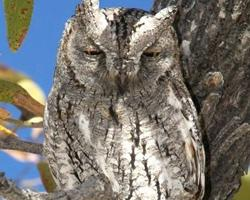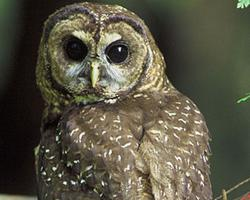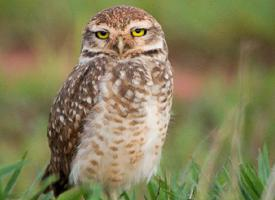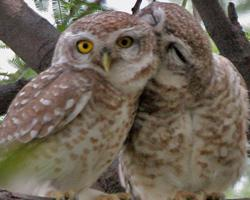
Váhy a míry
| Výška v kohoutku | od 19 do 24 cm |
|---|
Stav ohrožení
| Ohrožen |
Popis zvířete
The African scops owl (Otus senegalensis) is a small yet captivating bird species belonging to the Strigidae family, which encompasses various owls. This bird is primarily nocturnal and is known for its exceptional camouflage and elusive nature, making it a fascinating subject of study for bird enthusiasts and ornithologists alike.Physical Description:
The African scops owl is diminutive in size, typically measuring about 16 to 19 cm in length and weighing between 45 to 100 grams. Despite its small stature, this owl has a striking appearance. Its plumage is predominantly gray or rufous, intricately patterned with a mix of darker and lighter shades that perfectly mimic the bark of trees, aiding in its camouflage. The bird has a distinctive facial disc, which is characteristic of many owl species, framed by fine, dark rimming. Its eyes are large and yellow, offering a sharp contrast to its otherwise muted tones. The African scops owl has small, ear-like tufts that can be raised or lowered depending on the bird's mood or alertness level.
Habitat and Distribution:
The African scops owl is widely distributed across the African continent, favoring a range of habitats from savannahs, woodlands, and forests to well-wooded gardens and parks in urban areas. Its range extends from Sub-Saharan Africa to the southern Arabian Peninsula, demonstrating a remarkable adaptability to different environments.
Behavior and Diet:
This owl is predominantly nocturnal, spending the day roosted in tree cavities or against tree trunks, relying on its camouflage to stay hidden from potential predators. As night falls, the African scops owl becomes more active, embarking on hunts for its prey. Its diet mainly consists of insects such as beetles, moths, and crickets, although it may occasionally consume small mammals, birds, and reptiles. The owl employs a sit-and-wait hunting strategy, observing from a perch before swooping down on its prey with precision.
Vocalizations:
One of the most distinctive features of the African scops owl is its vocalization. It emits a repetitive, monotonous "prrp" sound at intervals of about two seconds, which can be heard throughout the night. This call plays a crucial role in territorial marking and communication between mates.
Reproduction:
The breeding season of the African scops owl varies across different regions, but generally coincides with the onset of the rainy season when food is abundant. The owl nests in tree cavities, laying a clutch of 3 to 6 white eggs. The female primarily incubates the eggs, while the male provides food for her and the chicks once they hatch. The young owls are ready to fledge in about 30 days but may remain dependent on their parents for a short while thereafter.
Conservation Status:
Currently, the African scops owl is listed as Least Concern by the International Union for Conservation of Nature (IUCN), indicating that it is not at immediate risk of extinction in the wild. However, like many species, it faces threats from habitat destruction and degradation, highlighting the importance of continued conservation efforts to ensure its survival.
In conclusion, the African scops owl is a remarkable bird, embodying the mysterious and enigmatic nature that owls are often associated with. Its presence across the African landscape underscores the rich biodiversity of the continent and the need to preserve its natural habitats for future generations.
Podobná zvířata
Nové fotografie zvířat
Top 10 zvířat
- Chinese water dragon (Physignathus cocincinus)
- Galápagos tortoise (Geochelone nigra complex)
- Dolphin gull (Leucophaeus scoresbii)
- Japanese macaque (Macaca fuscata)
- Colombian red howler (Alouatta seniculus)
- Sea urchins (Echinoidea)
- Moustached guenon (Cercopithecus cephus)
- Diana monkey (Cercopithecus diana)
- Common reed warbler (Acrocephalus scirpaceus)
- Common house mosquito (Culex pipiens)


